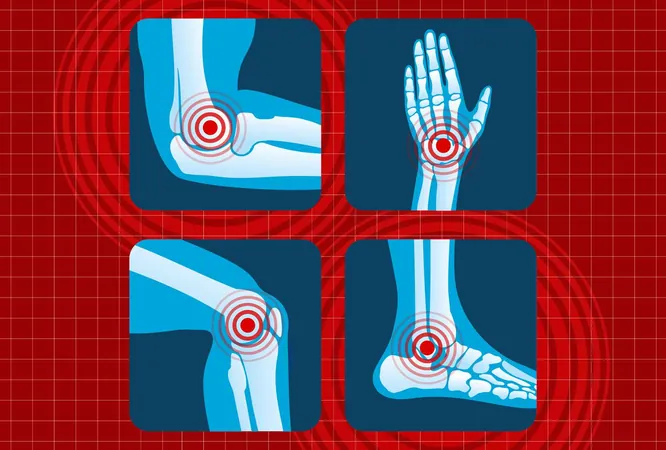
Unmasking the Truth: 5 Common Myths About Arthritis Debunked!
2025-01-11
Author: Nur
Arthritis: A Comprehensive Overview
Arthritis is a debilitating chronic condition that grips over 53 million adults in the United States alone. Contrary to popular belief, it’s not a single ailment but a collective term for more than 100 different types of arthritis and related diseases, as highlighted by the Arthritis Foundation.
Although commonly associated with older adults, arthritis can affect individuals of any age. Alarmingly, one-third of those with arthritis say it hampers their ability to work and live life fully. With persistent myths clouding the reality of arthritis, it’s high time we clarity the confusion surrounding its causes, treatments, and management strategies. Let’s delve into some widespread misconceptions, backed by science.
Myth 1: Arthritis Only Affects Older Adults
It’s a common belief that arthritis is primarily an elderly disease. However, experts like Sarah Schlichter, M.P.H., RDN, strongly argue otherwise. Nearly half of adults diagnosed with arthritis are under 65 years old, highlighting that age is just a number. Conditions such as rheumatoid arthritis, juvenile idiopathic arthritis, and psoriatic arthritis can strike younger adults and even children. Factors like genetics, infections, injuries, and lifestyle choices contribute to the onset of arthritis, irrespective of age.
Myth 2: Cracking Your Knuckles Causes Arthritis
You've probably heard the warnings: cracking knuckles leads to arthritis! Sounds familiar? This myth likely comes from the ominous popping sounds made during the act. However, studies have failed to establish any concrete link between knuckle cracking and the onset of arthritis. The sound actually results from gas bubbles in the synovial fluid, not from any harm to the joints. So, crack away—your joints are safe!
Myth 3: Exercise Makes Arthritis Worse
Living with arthritis can conjure fears of aggravating joint pain through exercise. Surprisingly, avoiding physical activity can lead to increased symptoms over time. Research indicates that exercise not only strengthens the muscles around joints but also improves flexibility and reduces inflammation. The Arthritis Foundation even endorses physical activity as one of the best ways to alleviate pain associated with osteoarthritis. Low-impact activities, such as swimming, cycling, or walking, can be particularly beneficial. Always consult a healthcare professional before starting any exercise regimen tailored to your needs.
Myth 4: All Types of Arthritis Are the Same
Although many lump arthritis into a single category, it encompasses a plethora of distinct disorders. The two most prevalent types, osteoarthritis and rheumatoid arthritis, have unique causes and treatment methods. Osteoarthritis involves gradual joint wear and tear, while rheumatoid arthritis is an autoimmune disorder where the body mistakenly attacks its joints. Understanding the type of arthritis you're dealing with is crucial for effective management, so seek guidance from your healthcare provider for a proper diagnosis.
Myth 5: There’s Nothing You Can Do About Arthritis
While it’s true that there’s no cure for arthritis, numerous strategies exist to manage symptoms and enhance your quality of life. Dietary changes can have a profound impact. Registered dietitian Sarah Schlichter advocates for an anti-inflammatory diet, suggesting foods rich in omega-3 fatty acids, fruits, and vegetables. The Mediterranean diet, abundant in anti-inflammatory foods like fatty fish, whole grains, nuts, and seeds, shows particular promise, particularly for those with rheumatoid arthritis.
Strategies to Manage Arthritis:
1. **Stay Active:** Engage in low-impact exercises like swimming, biking, or walking to boost joint health and mobility. 2. **Follow an Anti-Inflammatory Diet:** Fill your plate with whole foods rich in nutrients, like fruits, vegetables, legumes, and healthy fats, to combat inflammation. 3. **Maintain a Healthy Weight:** Carrying excess weight can place significant strain on joints, exacerbating symptoms. Weight management can alleviate this burden. 4. **Manage Stress:** Chronic conditions like arthritis can heighten stress levels, negatively impacting symptoms. Techniques like mindfulness, meditation, and therapy may help manage both stress and arthritis symptoms.
In conclusion, understanding the complexities of arthritis can empower those affected to take proactive steps toward symptom management and improved quality of life. With the right combination of exercise, diet, and medical guidance, arthritis doesn’t have to dictate your life. Arm yourself with knowledge and reclaim your comfort today!
 Brasil (PT)
Brasil (PT)
 Canada (EN)
Canada (EN)
 Chile (ES)
Chile (ES)
 Česko (CS)
Česko (CS)
 대한민국 (KO)
대한민국 (KO)
 España (ES)
España (ES)
 France (FR)
France (FR)
 Hong Kong (EN)
Hong Kong (EN)
 Italia (IT)
Italia (IT)
 日本 (JA)
日本 (JA)
 Magyarország (HU)
Magyarország (HU)
 Norge (NO)
Norge (NO)
 Polska (PL)
Polska (PL)
 Schweiz (DE)
Schweiz (DE)
 Singapore (EN)
Singapore (EN)
 Sverige (SV)
Sverige (SV)
 Suomi (FI)
Suomi (FI)
 Türkiye (TR)
Türkiye (TR)
 الإمارات العربية المتحدة (AR)
الإمارات العربية المتحدة (AR)